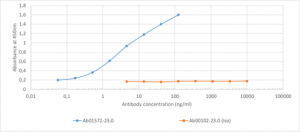As the spring-summer season arrives in the Northern Hemisphere, once again the menace of Lyme disease casts a troubling shadow on those who dare to wander among bushes, forests and grasslands. There, hidden from a superficial glance, hide little arachnids – ticks, some of which bear a dangerous bacterium – Borrelia burgdorferi – the infectious agent which causes Lyme disease (also known as Lyme borreliosis). What in many starts with a characteristic erythema migrans rash, can later proceed to a serious disease with symptoms such as facial palsy, arthritis, carditis and inflammation of the nervous system if left untreated (Ross Russell et al., 2018). In many regions of the world, the number of cases of the disease are increasing, and thus development of effective diagnostic and therapeutic approaches is of fundamental importance.
To address these needs, Absolute Antibody offers two very effective antibodies against Outer surface protein A (OspA) of Borrelia burgdorferi – clones LA-2 (Ab01070) and 184.1 (Ab01572) (Figures 1 and 2). OspA, which is next to OspB, is one of two major Borrelia surface antigens (Jiang et al., 1990). LA-2 is a neutralizing, protective antibody that was shown to guard from Borrelia burgdorferi infection when passively transferred to SCID mice (Schaible et al., 1990). As a result, LA-2 is as a promising candidate for research on potential therapies. Furthermore, the epitope bound by this clone has a crucial importance for the development of vaccines against the Lyme disease, as it was demonstrated that protective vaccines in hamsters correlate with high abundance of LA-2-eqivalent antibodies (Johnson et al., 1995).
Our two anti-OspA antibodies help to enable key research and diagnostics approaches in a few ways:
- As a matched pair for diagnostic sandwich assays, 184.1 binds to an epitope near the N terminus of OspA (Schubach et al., 1991) while LA-2 is thought to bind to a more distant hypervariable region (Li et al., 1997).
- Absolute Antibody’s engineering platform allows us to offer these clones in various isotype and species formats, such as human, rabbit and dog. These can be used to further investigate the infection and pathogenetic mechanisms in model organisms, as well as facilitate the development of veterinary diagnostic and therapeutic undertakings in dogs which are often affected by lyme disease.
- These two antibodies are available in both IgG and IgM human and dog versions, which allows for the construction of appropriate serological controls of Borrelia infection for diagnostic tools in both humans and dogs.

Fig 1. Binding curve of anti-OspA antibody 184.1 (Ab01572) to Borrelia burgdorferi OspA (MBP-Tagged). ELISA Plate coated with Borrelia burgdorferi OspA (MBP-Tagged) at a concentration of 5 µg/ml. A 3-fold serial dilution from 10,000 ng/ml was performed using Ab01572-23.0. For detection, a 1:4000 dilution of HRP-labelled anti-rabbit IgG antibody was used.

Fig 2. Binding curve of anti-OspA antibody LA-2 (Ab01070) to Borrelia burgdorferi OspA (MBP-Tagged). ELISA Plate coated with Borrelia burgdorferi OspA (MBP-Tagged) at a concentration of 5 µg/ml. A 3-fold serial dilution from 10,000 ng/ml was performed using Ab01070-10.0. For detection, a 1:4000 dilution of HRP-labelled anti-human IgG antibody was used.
Latest News
Upcoming Events
Please join us at the following conferences and events. Stop by our booth, or get in touch to arrange a meeting.
See All Dates
 United Kingdom (UK)
United Kingdom (UK)